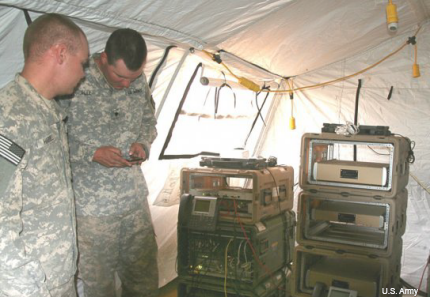4G LTE and other high-speed tools ready for the battlefield
The Army boosts bandwidth at forward deployed posts with a fast, secure Wi-Fi network.

Soldiers from the 86th Expeditionary Signal Battalion evaluate the 4G LTE/Wi-Fi system during NIE 14.2.
In its quest to increase bandwidth on the battlefield, the Army is introducing a package of high-speed communications technologies, including a 4G LTE infrastructure that allows commanders and soldiers at a forward base to securely connect to the network from their smartphones.
The 4G service is part of the Tactical Network Transmissions, or TNT, tools intended to boost mobile network performance for coalition forces and first responders, provide Wi-Fi coverage at command posts, and do it while reducing size, weight and power requirements, the Army said.
TNT was fielded during the Army’s recent Network Integration Evaluation 14.2, held at Fort Bliss, Texas.
"Soldiers and commanders in tactical operations centers need more bandwidth for data intensive tasks like sending large PowerPoint files, maps and full motion video," Lt. Col. Joel Babbitt, product manager for Warfighter Information Network-Tactical, Increment 1, said in an Army release. "The transformational nature of these technologies is increasing situational awareness and effectiveness for Soldiers at all echelons."
4G is the current, fourth generation of cell phone technology. LTE, for Long-Term Evolution, is a standard for high-speed data over phones and other mobile devices (and as the logical upgraded path from GSM and CDMA networks, could become the first global mobile phone standard). Combined, they make for the fastest currently available service.
To ensure the security of transmission, the 4G LTE/Wi-Fi system uses the National Security Agency’s Commercial Solutions for Classified encryption.
"Commanders can just pick up their cell phones and directly call or text anyone they need to within the radius. It's a much faster line of communication," said Cpl. Michael Bullis, B Company, 86th Expeditionary Signal Battalion, who operated the equipment at NIE 14.2. "On the software end, soldiers have a centralized knowledge base on their phones, and the Army will continue to add apps to provide a more realistic view of what is going on in operations."
Medics, for example, can use apps such as “patient tickets,” which allows them to record information on their phones and send it, rather than calling it in or returning to the base, Bullis said.
The TNT package also features some other technologies designed to boost bandwidth. Among them:
Tropo Lite, a transit-case tropospheric scatter communications system that provides an alternative to satellite communications. The Tropo terminal enables high-speed transmission of large data sets (even over mountains) by bouncing microwaves off of the atmosphere.
“TRILOS,” an acronym for transportable line-of-sight radio system, in this case a smaller one that boosts legacy radio throughput from 16 megabits per second to 200 Mbps.
Mission Network Enclave, of MNE, a network stack that can be configured in about 10 minutes for any of four networks: the Secure IP Router, Non-secure IP Router, or the coalition networks, or for commercial Internet and phone service. MNE not only helps enable coalition operations, but can also come in handy when the military is called to assist after disasters such as Hurricane Katrina, the Army said.
"MNE is going enable us to integrate all the different civilian agencies and combine all of their different radio systems and frequencies to be able to talk quickly between each of the agencies, and with everyone out there,” said Maj. Rickie Meers, operations officer for the 86th Expeditionary Signal Battalion. “That is invaluable."
NEXT STORY: Army adding to its supply of Manpack radios




